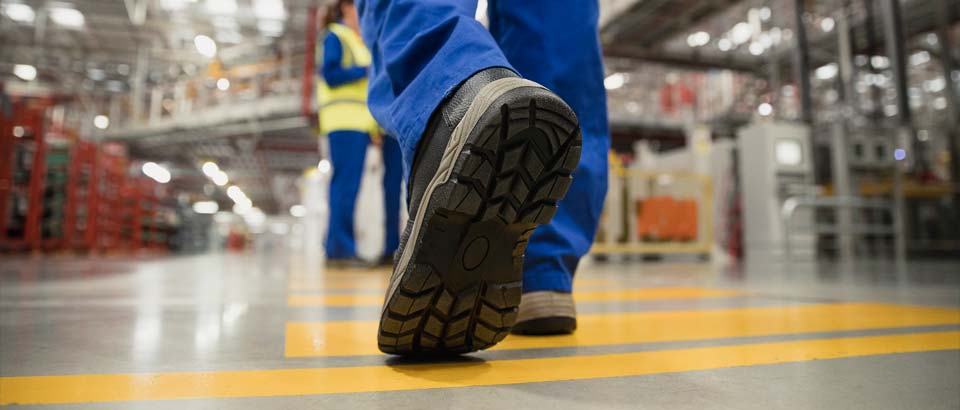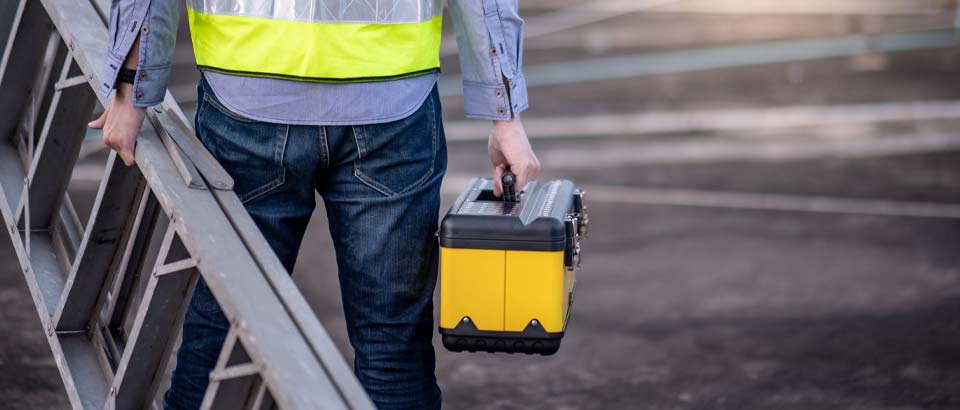May 6, 2024
Slips, trips and falls are things we all try to avoid on the job. According to the National Safety Council, 450,540 people were hurt badly enough by falls from 2021 to 2022 to have to take days off of work. They averaged 14 days off work and most often suffered from sprains, strains and tears.1 That makes slips, trips and falls the third highest reason for Days Away from Work, Job Restriction, or Transfer (DART) cases. Even more distressing, there were 865 deaths, making it the second highest event that
causes work-related deaths, behind only transportation incidents.2
Employeescan suffer one of these accidents in any career, particularly in construction; education; health care; building cleaning and maintenance; agriculture, forestry, fishing and hunting; transportation and warehousing industries.3 Since this is a common concern shared across many fields, we’ve put together some ways as an employer that you can keep your workplace safer and be better prepared if an accident does happen.

Safety Starts With the Individual
The good news is that slips, trips and falls can be prevented. By sharing some safety tips during team meetings, coffee break chats and even quick daily huddles, you can help everyone in your company feel more prepared and safer on the job. Here are some basic rules to share:
- Watch out for smooth surfaces, such as newly waxed floors and loose carpeting.
- Never carry a load that you cannot see over.
- Avoid jumping off of landings and loading docks.
- Consider wearing shoes with non-slip soles.
- Practice safe walking skills, such as taking short steps on slippery surfaces to keep better balance.
MedExpress Pro Tip: To improve your center of gravity and balance, walk by pointing the feet slightly outward.2
Keeping the Workspace Safe as an Employer
A great way to prevent these mishaps is to better prep your work environment. That way, you can prevent accidents before they even happen.
- Install handrails on all stairways.
- Ensure that all floors are clean and clear of clutter.
- Keep cabinets and drawers closed.
- Place all electrical, computer and phone cords outside of high-traffic areas.
- Keep pathways open by moving and arranging equipment and/or furniture.
- Remind others to never stand on chairs or tables.
- Never let grease accumulate at your workplace.
- Clean up or report spills right away.

Safety for Construction Workplaces
Safety on the construction jobsite is something that everyone should take seriously. We have put together some easy to remember tips for several situations that your employees may face on the job:
Ladders: Before an employee goes up a ladder, they should ask themselves: “Do I need to be climbing up this ladder?” If the answer is yes and there’s no other way to do the job safely, then the next steps should be to assess the risk and use the correct (never old or damaged) equipment, which includes slip-resistant shoes.
When setting a ladder, they should be on level ground. Then, scan the area around the ladder to ensure there are no obstacles in the way. Remember – never lean a ladder against an unstable surface. If the situation requires climbing outside, check the weather conditions first.
Always maintain proper ladder placement. An extension or straight ladder should always be placed a foot away from the resting surface for every four feet of ladder height and should always extend at least three feet over the top edge of the climb. Before climbing, workers must securely fasten the ladder to an upper support (if possible). Plus, they should always face the ladder while climbing and never stand higher than the third rung from the top. Never lean or reach for objects while on a ladder. Instead, climb down and move the ladder to the object. It’s also essential to have someone support the ladder from the bottom.
Finally, employees should discuss with their co-workers if there is any safety equipment that they need before climbing occurs. They should also ensure that the worksite and equipment are in good working order and that they are up to date on all safety training before anyone climbs their first step.
Elevated surfaces: When construction happens on a roof or other elevated surface, the chances of accidents increase. This can be due to weather conditions, worker inexperience, lack of training or even lack of the correct safety equipment. To protect your workforce, you should implement a fall protection program and everyone should be trained on fall protection. One person should also be trained and assigned to inspect all fall equipment before each and every use. Additionally, anyone that works on a roof should be wearing and using fall protection properly.
Scaffolds: Train and assign a person to supervise scaffold set up by following the manufacturer guidelines and Occupational Safety Health Administration (OSHA) standards. They should also inspect all scaffolds and scaffold parts before they are used.
When placing a scaffold, a stable ground and surface must always be selected. Guardrails or a fall arrest system must always be used when the scaffold is ten feet or more above ground level. Additionally, scaffolds should always be fully planked and the wheels must be locked before anyone mounts the work platform. Most importantly, no one should ever work alone on a scaffold.
What Do You Do If an Accident Happens?
Again, while we all work hard to prevent them, accidents do happen. The following steps should be followed to not only ensure that help arrives as quickly as possible, and the accident is properly reported.
- Immediately after an accident, ask the employee to check their body for pain or injuries. If they can get up, they should. However, if they are hurt or unable to stand, ask them to remain on the floor until 911 is called and help arrives. No one should attempt to move or lift them.
- No matter how minor an accident is, the injured employee needs to seek medical attention. Immediate evaluation of injuries protects both them and your company. They should keep copies of any scans or X-rays, medical records, any billing that occurs, photos of your injuries and any statements made by providers who have examined their injuries.
- Document what caused the fall, such as wet flooring with no signage, uneven surfaces, clutter or cracks in the floor or sidewalk. This can correct the issue and protect other employees.
- After receiving proper medical attention, the accident must be reported to the employee’s direct superior or the HR department as soon as possible. Ensure that your employee handbook has a process for reporting injuries.
- Depending on the severity of the injury, the employee may need to enter a workers’ compensation program or receive continuing care.
How Can MedExpress Help?
At MedExpress, your employees can get the right care in the right setting. From urgent care when you need us to reducing your overall workers’ compensation costs, OSHA-recordable injuries, and lost time due to injury, we’re here for you and your company.
Originally posted July 21, 2022. Updated May 6, 2024.
want to partner with us?
Learn how our full range of occupational medicine and urgent care services can help keep your employees healthy.
References:
1 National Safety Council. Work Overview – Top Work-related Injury Causes. Accessed March 5, 2024.
2 National Safety Council: Top Work-Related Injury Cases. Accessed March 5, 2024.
3 National Safety Council: Most Dangerous Industries. Accessed March 5, 2024.
4 OSHA: Slips, Trips and Falls. Accessed May 13, 2022.
